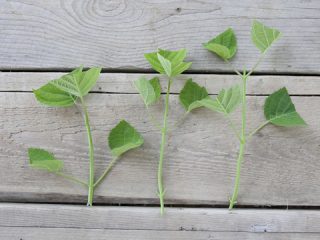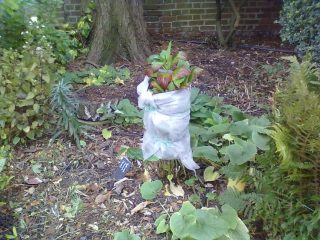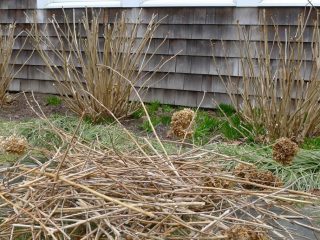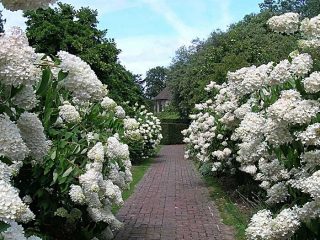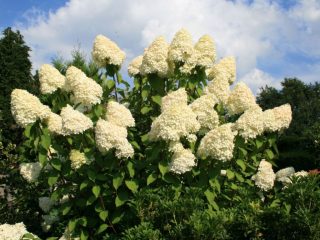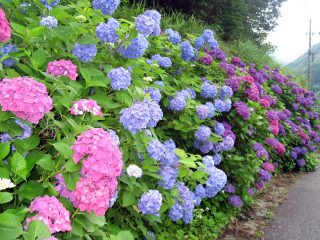Content
Oakleaf hydrangea was first described by American naturalist William Bartram in the late 18th century. But it took its place in the gardens of the New and Old Worlds much later, since the first experience of growing an ornamental crop was unsuccessful. Only at the beginning of the 20th century, when the agricultural technology of oakleaf hydrangea was understood, was it able to enter the design of ornamental plantings, almost completely displacing its relative, macrophylla. This is a beautiful and elegant plant with good weather resistance.
Description of oakleaf hydrangea
Oakleaf hydrangea (Hydrangea Guercifolia) is a deciduous shrub with a height of 150 to 200 cm. The trunk of the crop is straight and hardened near the roots. The growth of oakleaf hydrangea is up to 50 cm per year.The root system is taprooted, with several large branches located at a depth of up to 40 cm.
A special feature of this species is its leaves with a characteristic “oak” shape. Their size can reach up to 25 cm, they have sharp and jagged edges. The pattern of veins in oakleaf hydrangea is embossed and clear.
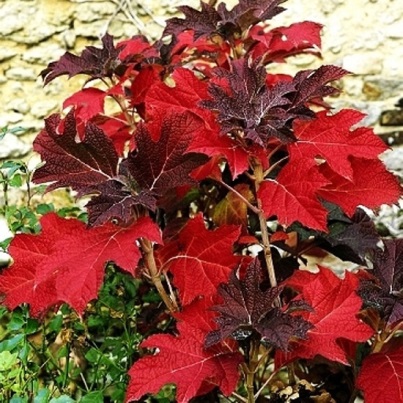
The large seven-lobed leaves of oakleaf hydrangea are pubescent and can change color
During the season, two changes in color of the vegetative part of the plant occur. In early spring, oakleaf hydrangea foliage is dark green. In August, the process of repainting it into a rich red color begins, which in September changes to dark burgundy. In fact, only the green leaves are completely pubescent; as they change, the hairs remain only on the lower side.
Oakleaf hydrangea flowers are collected in large panicle inflorescences.
Most often they have a cone shape and consist of many white flowers with a diameter of up to 30 mm. Their smell is sweetish, barely noticeable. Oakleaf hydrangea blooms for a long time: it begins in mid-June and lasts until the end of September.
Varieties of oakleaf hydrangea with photos and names
There are about a dozen popular plant varieties. All of them find application in landscape design.
Harmony
This variety of oakleaf hydrangea has an interesting difference in the anatomy of the flowering part. In other respects it repeats the original culture.
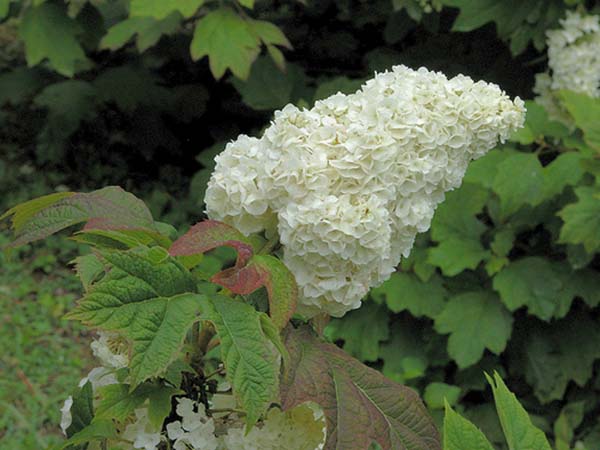
The inflorescences of the Harmony variety have a larger number of flowers and a length increased to 30-32 cm
The mass of hydrangea flowers can be so significant that the stems can bend.
Snow-white domes
Similar to Harmony, it has a larger number of flowers in an inflorescence. Moreover, its shape may not be elongated, but spherical.Otherwise, the culture is identical to the original oakleaf hydrangea.
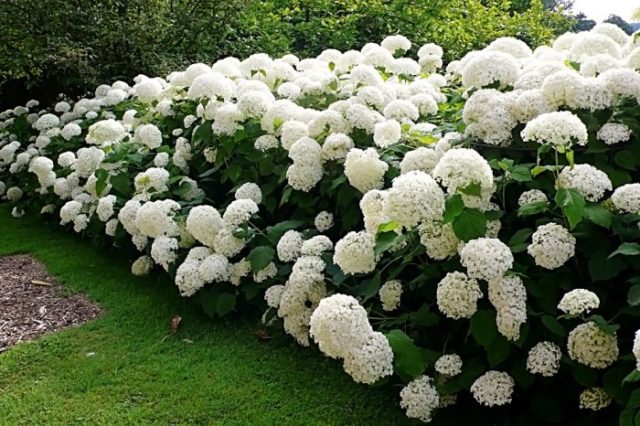
The main difference between Snow White domes is the round shape of the inflorescences
Burgundy
One of the most beautiful varieties. It has few differences, but they all seem to “strengthen” the characteristic features of oakleaf hydrangea. So, for example, the color of Burgundy is the brightest in autumn. Young leaves, on the contrary, are rich green. The shoots are golden yellow.
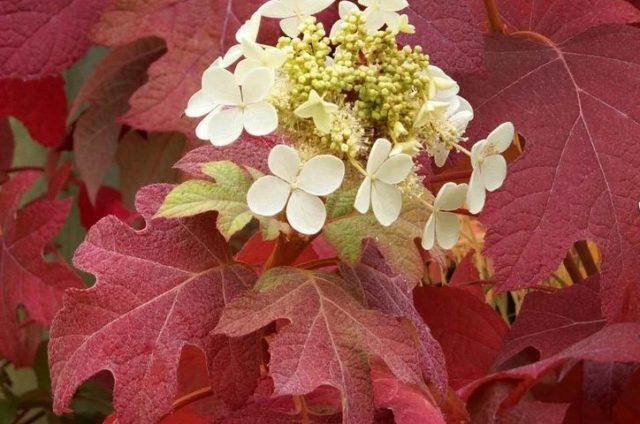
Burgundy leaves are most reminiscent of oak leaves in shape - there are rounded lobes, no hairs
Flowering lasts from late June to August. The petals first have a white or cream tint, then change to pinkish.
Tennessee clone
It has relatively small, numerous inflorescences. Their length rarely exceeds 10-12 cm.
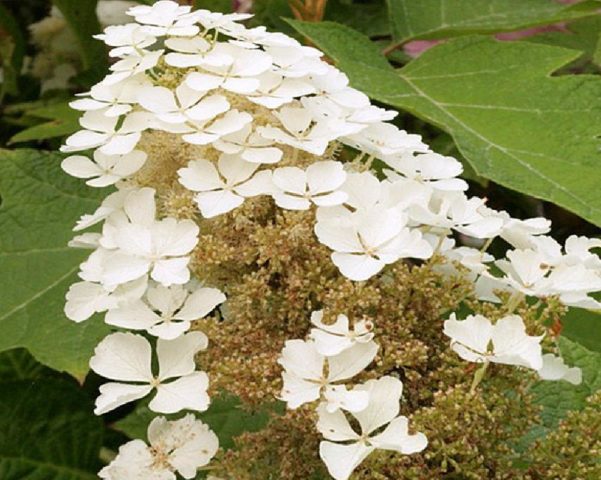
The flowers of the Tennessee clone are creamy; they have a characteristic petal shape, narrowed at the base.
The number of inflorescences on a bush can exceed 30-40 pieces. Which is, on average, twice as much as any other variety.
Snow Queen
This variety of oakleaf hydrangea has been bred to produce large flowering parts. It has large massive flowers (up to 5 cm in diameter) and inflorescences. The leaves are relatively thin, practically without pubescence.
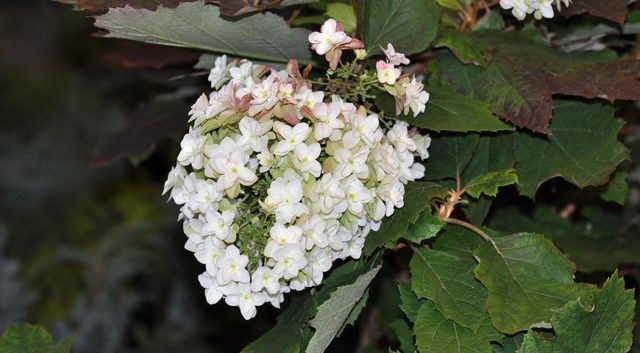
The mass of Snow Queen's inflorescences is very large, so the branches with them are pressed to the ground
The color of the petals of this variety can be white or pinkish. Sometimes there are different colors on one plant.
Oakleaf hydrangea in landscape design
The culture is capable of fulfilling all the roles of a large and beautiful bush with abundant flowering. It can be used as the center of a composition or to give accents to a particular object.In mixborders, oakleaf hydrangea is usually used, shortening the shoots to 1.2-1.5 m.
The shrub can also be used to create continuous monoculture plantings.
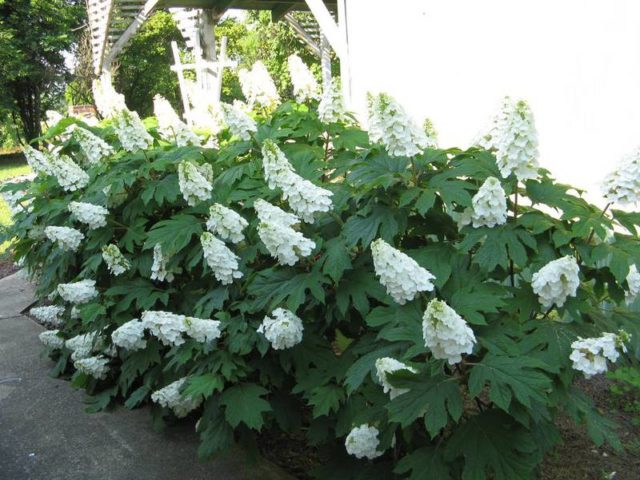
You can often find oakleaf hydrangea as a hedge or high border.
However, there are some nuances. They concern the fact that, despite the good winter hardiness of oakleaf hydrangea, some of the buds can freeze from frost. Moreover, this is observed even at relatively low temperatures. And, since the generative buds of oakleaf hydrangea are renewed every two years, it may happen that some bushes will be left without flowers, which will significantly worsen the appearance of the garden.
Winter hardiness of oakleaf hydrangea
Despite its almost subtropical origin, the plant has good frost resistance. Most varieties of oakleaf hydrangea have frost resistance zone 4, that is, they can withstand temperatures down to -35 ° C.
Some varieties have much lower resistance (zone 6, that is, 23 ° C). In any case, when purchasing seed, you need to make sure that the crop is suitable for a particular climate.
Planting and caring for oakleaf hydrangea
Planting is best done in spring, early or mid-April. If you want to do this in the fall, then the optimal month would be October.
Selection and preparation of a landing site
The culture feels best in partial shade. The quality and fertility of the soil does not play a special role for oakleaf hydrangea. There are only two main requirements for the site, but both are critical:
- acidity level pH in the range of 5.0-6.5;
- lack of wetlands.
The site practically does not need preliminary preparation; the holes are dug the day before planting the planting material, watered abundantly and nothing else is done with them.
Landing rules
It is best to plant oakleaf hydrangea in the morning. A substrate consisting of equal proportions of the following components is placed in the dug holes:
- garden soil;
- peat;
- sand;
- humus.
Next, place a seedling on the resulting mixture and add soil to the edges of the hole. After planting, light watering is done, the soil is loosened and mulched with sawdust or peat.
Watering and fertilizing
The crop needs enough moisture from natural precipitation. Therefore, oakleaf hydrangea is watered exclusively during drought. In this case, the frequency of watering is from 1 to 2 times a week, depending on the moisture content of the top layer of soil. One bush requires up to 10 liters of water.
Feeding is carried out every month, starting in May. In total they should be applied 4-5 times. The first consists of nitrogenous fertilizers (urea in the amount of 50 g per 1 sq. m), the rest - from potassium-phosphorus fertilizers. In the latter case, it is best to use 30 g of superphosphate per 1 square meter. m.
Pruning oakleaf hydrangea
Starting from the age of two, pruning is done to make the plant decorative. In the spring, it is of a sanitary nature - damaged and diseased branches are removed, as well as those that grow inside the crown.
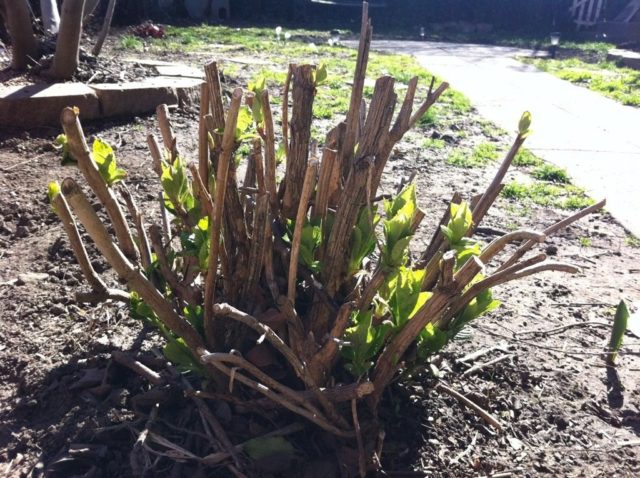
Before the buds begin to bloom, the crown is shaped into a semicircle.
In autumn, it is necessary to cut off only the faded parts of the plant. This procedure is done immediately before covering the bush for the winter.
Winter shelter for oakleaf hydrangea
Despite the plant’s fairly high frost resistance, its buds can freeze out even at relatively low temperatures (about -20 °C). To prevent the plant from losing its decorative appearance next year, it must be covered.
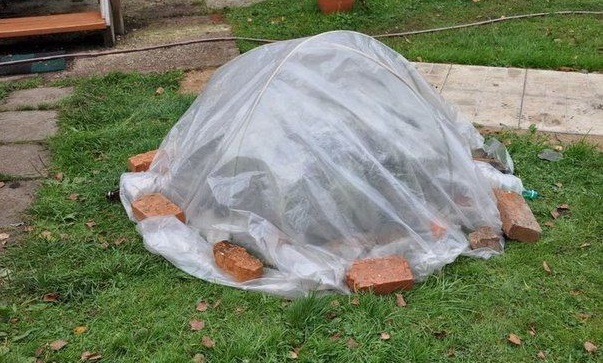
Annual and biennial bushes should be hilled up, covered with sawdust and covered with polyethylene.
Adult specimens of oakleaf hydrangea are bent to the surface of the soil and covered with sawdust, spruce branches or fallen leaves. Place plastic film on top.
Sometimes the following technique is used: the branches are tied, and a metal frame is installed above the bush, which is filled from the inside with fallen leaves. As in other cases, polyethylene is stretched over it. When the snow melts, the shelter is removed.
More details about sheltering oakleaf hydrangea for the winter in the video:
Reproduction
The plant is propagated by all available methods:
- seeds;
- cuttings;
- dividing the bush;
- layering.
Unlike many ornamental crops, seed propagation in oakleaf hydrangea is quite effective and fast; the material is sown in seedling boxes in February. A mixture of peat, sand and garden soil is used as a substrate.
The first shoots hatch in March. Seedlings are grown all summer and then planted in open ground.
Dividing the bush is applicable for adult plants with more than a dozen large stems. It is allowed to separate the root with a shovel without digging it out of the ground.
The most effective propagation is from cuttings.They are harvested in July from last year's stems, which have at least three pairs of leaves.
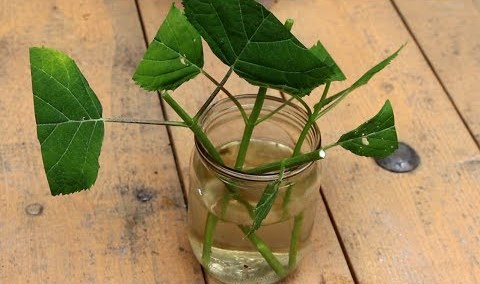
The lower leaves are cut off, and the cuttings themselves are placed in water in which a few drops of Epin are dissolved
The roots appear in about a month, after which the cuttings are planted in individual containers, where they grow indoors until April of the following year, when they are planted in open ground.
Diseases and pests
Oakleaf hydrangea is resistant to most diseases, but sometimes it is affected by fungal infections. The most dangerous for the crop is gray rot. It affects plants of any age.
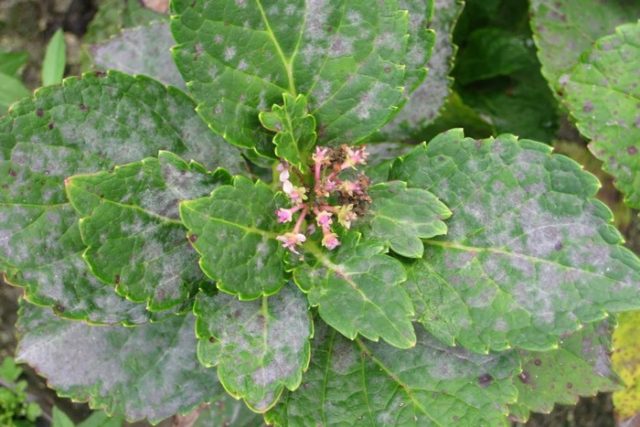
Symptoms of rot - the appearance of gray spots on the leaves
Usually the cause of the disease is a violation of the plant's conditions - high humidity or stagnation of water at the roots. Treatment consists of spraying the crop with copper-containing preparations and changing watering conditions.
The most common pest that attacks oakleaf hydrangea is spider mites. But here the reason is completely different - excessive dryness.
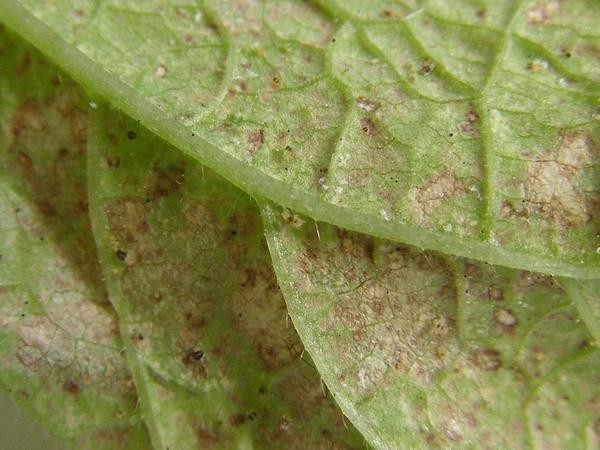
Small spider mites are most often hidden on the lower part of the leaves.
To combat this pest, you need to use acaricides: Actellik, Aktaru or Fitoverm. But, as in the case of diseases, the main thing in treatment is to adjust the conditions under which the plant is kept.
Conclusion
Oakleaf hydrangea is a beautiful crop with large inflorescences and decorative leaves. It can be used for various design solutions in gardens and parks in temperate climates. The culture has good immunity to pests and diseases. To preserve its decorative appearance, it is recommended to cover the plant for the winter.
Reviews of oakleaf hydrangea
